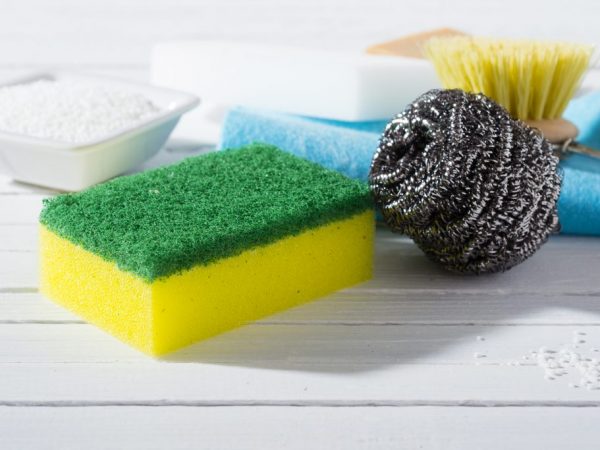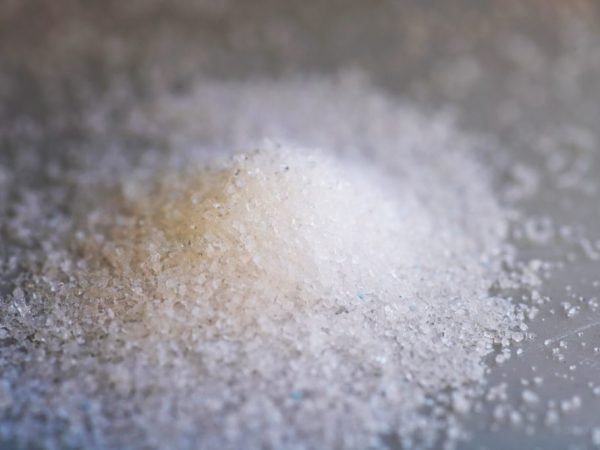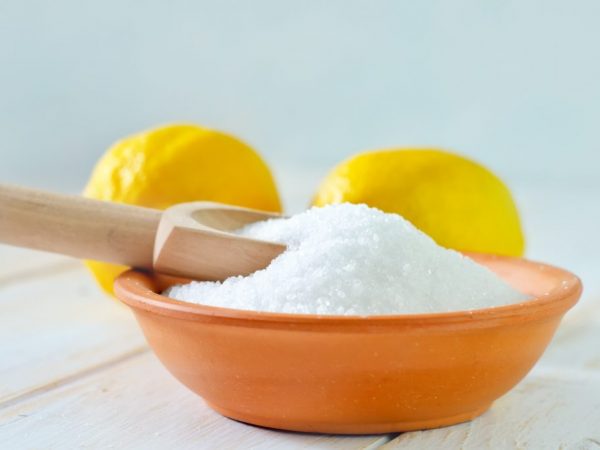Cleaning household items with citric acid
Household appliances and appliances last for many years if their owners take care of their condition. Regular cleaning is an important step towards helpers in the kitchen and bathroom. Home remedies are often used for this, among which citric acid is the most popular and universal.
- Features of citric acid
- Cleaning the washing machine
- Cleaning steps
- Advantages and Disadvantages of Acid Cleaning
- Dishwasher cleaning
- Microwave cleaning
- Internal cleaning rules
- External cleaning of the microwave
- Descaling the kettle and coffee maker
- Cleaning the iron from plaque
- Plumbing cleaning
- Cleaning the car cooling system
- Conclusion

Cleaning household items with citric acid
Features of citric acid
Citric acid has a rich chemical composition. It has many components that begin to react actively to the environment under certain conditions. It is a crystalline powdery substance of bright white color with a specific citrus aroma and an acutely expressed sour taste. More often in the food industry, citric acid is used in baking, cooking, conservation, as well as in other areas. For home cleaning, monohydrate is used for cleaning household appliances, plumbing, carpet cleaning, etc.
This substance reacts actively with hot water when mixed with soda. It is able to fight limescale, dissolving it and crushing particles that have eaten into the materials. But if you apply a solution with too hot water for a long period of time, it can damage plastic and soft metal parts, corroding their top layer. It is also used to remove greasy stains, taking advantage of its ability to break down fat molecules and remove them from surfaces. It is often used in combination with baking soda and vinegar.
Cleaning devices and internal parts of equipment with monohydrate must be safe for the skin of the hands. Therefore, use rubber gloves without fail.
Cleaning the washing machine
Systematic cleaning of the washing machine with citric acid will save you from rapid aging of equipment and quick breakdown. Hard water, which is used for washing laundry, after a while leaves a large amount of salt, which is deposited on the heating element and other important parts of the mechanism. Multi-layered limescale begins to wear out the machine and the washing process becomes ineffective.
Cleaning steps
To clean the washing machine from limescale with citric acid, take the powder itself and a small piece of dry and clean cloth directly. The process takes place in stages:
- check the drum for the absence of things in it, since citric acid is able to discolor the fabric, dissolving the paint;
- an automatic machine with a volume of up to 7-8 kg of washing requires 90-100 g of powder, for smaller equipment (up to 4 kg) 50-60 g is enough;
- it is better to pour the monohydrate into the drum and into the powder tray;
- choose the longest possible mode with all the main processes - soaking, wringing, rinsing at a temperature of no more than 60 ° C;
- at the end of the washing process, check the condition of the drum cuff, where dirt and sediment can be found in the lapel, which is wiped off with a clean cloth;
- after that, clean the drain filter from the remnants of large pieces of scale and dry the container for the powder.
It is permissible to clean the washing machine with citric acid up to 3 times a year with high water hardness. Softer water does not affect the machine so devastatingly, therefore, it is allowed to clean the washing machine with citric acid about 2 times a year. A preventive measure is carried out after every 30th wash.
Advantages and Disadvantages of Acid Cleaning
To clean the washing machine with citric acid, they buy this common and inexpensive product at any store. Its availability for every budget is a big plus. The useful components of the monohydrate act quickly and effectively, therefore it is chosen to combat the most difficult contaminants, which are water salt scale on the heating element of the washing machine.
Washing machine citric acid acts as a conditioner. Deposits on the rubber part of the drum often develop an unpleasant odor due to the growth of bacteria and harmful microorganisms in this area. The substances contained in lemon disinfect the drum cuff and impart a pleasant citrus scent to the entire interior of the machine. The applied citric acid is harmless to the body. After cleaning, use the washing machine without harm to the laundry.

Acid disinfects the drum of the machine
Citric acid is not harmful if used in certain doses and at a clearly marked temperature regime. Clean the washing machine from limescale with citric acid, possibly with hot water, which does not exceed 60 ° C. The temperature regime, which almost reaches a boil (90 ° C), together with a large amount of substance, often leads to deformation of the plastic and rubber parts of the mechanism, since the solution is caustic and aggressive. To clean the washing machine with citric acid in such conditions means to doom it to quick breakdown.
Dishwasher cleaning
The dishwasher also has an element that heats up the water. Salt scale also appears on these parts of the mechanism over time, and grease accumulates inside the cabinet itself. The properties and effectiveness of citric acid as a home remedy for cleaning this household appliance is highly effective.
To tidy up the condition of the dishwasher, you need to do the same as for cleaning the washing machine with citric acid:
- the detergent compartment is filled with one sachet of powder - 25 g;
- the washing mode is switched on at the maximum water temperature;
- upon completion of cleansing, they re-include another mode without adding any means - for rinsing the machine;
- at the end of the entire process, clean the filter, wipe the entire cabin cavity with a damp, clean cloth, including the seals and the door.
Microwave cleaning
The use of this food additive as a solvent for grease stains inside the microwave oven is also popular. To do this, take powder or cut citrus fruits - it is easier to release chemically active elements this way. They use citric acid to rinse the warming and cooking machine with some differences from the previous methods.
Internal cleaning rules
One sachet of powder (25 g) is diluted with a glass of cold water, placed in a heat-resistant dish. It is important that the solution occupies no more than half of the container, otherwise it will splatter and fall on the elements of the device.The dishes are placed in the microwave and the appropriate mode is set in which it will be possible to boil the product for 5 minutes without stopping. The steam, saturated with citrus enzymes, will dissolve the fat deposits on the walls of the appliance. Repeat the procedure if necessary, in case of heavy soiling.
After the end of the program, the door is not opened, leaving the interior exposed to steam. While the oven is cooling down and the fat is steaming inside it, it is better to disconnect it from the mains. After complete cooling, the chamber is wiped with a sponge with foamed detergent. It is better to have enough foam to remove greasy stains. The washed oven is wiped dry at the end with paper towels to get rid of streaks and dirt residues.
External cleaning of the microwave
The surface of the microwave oven is also often contaminated with drops of fat and food. Lemon juice of the fruit cut in half will come to the rescue. An effective method is also to wipe the outer skin with specially prepared water (a weak solution of citric acid, in which, for greater effect, it is allowed to put 1 teaspoon of soda). The solution is left for an hour to allow time to dissolve the grease and act effectively against dirt.
Wash off the remaining solution and grease with a sponge moistened with detergent. Then the surfaces are wiped with clean water and wiped dry with paper towels. After the end of the process, a subtle citrus aroma will remain.
Descaling the kettle and coffee maker

Citric acid is safe for humans
When hard water is boiled, lime deposits settle on the walls of the kettle. To get rid of this problem, 5 tablespoons are poured into the cavity of the device. food monohydrate, pour warm water to the level of the sediment and leave for several hours. The electric kettle is rinsed more slowly with running water. If you start boiling the reagent, the consequences can be dire - the teapot coating will deteriorate. The acid itself is safe for humans, therefore, after purification, simple boiling of pure water will be sufficient.
The coffee maker is also prone to salt precipitation from hard water during boiling. Therefore, to clean it, a solution of 1 tsp is poured into the water compartment. acids with liquid. Next, the normal coffee brewing process is started, allowing water to flow through the coffee holes. Then clean water is boiled for washing. Caring for your coffee maker includes regular cleaning every 2-3 months.
Cleaning the iron from plaque
Lime settles in the water tank inside the iron. To bring it out, pour in a water-acid agent inside. Its composition includes already familiar components - a spoonful of powder is diluted in a glass of water.
When cleaning, heat the iron to the highest possible temperature. Take an unwanted old towel or cloth and iron it with steam. In case of stubborn dirt, pieces of lime fall out directly from the holes in the base of the appliance.
Plumbing cleaning
Unpleasant white deposits on shiny plumbing fixtures and surfaces and lime deposits in taps and faucets are a significant problem for housewives. They get rid of it with the help of different solvents, but food monohydrate is the safest and most effective among home remedies. It is used in a similar way as for kitchen appliances:
- To clean the taps, a solution is prepared, the ratio of the components is 2 tbsp. for 1 glass of water. They impregnate paper towels or cotton cloth with it, wrap the material over the faucet along the entire length and leave for 2-3 hours. Then they wipe with a sponge with detergent, for especially dirty places use a small brush, rinse with cool water. To get rid of lime deposits inside the taps, a bag filled with lemon water is tied to it, immersing the spouts in the solution. After a few hours, the inside is cleaned with a brush.
- A shower spray clogged with sediment is also cleaned with a 1: 1 solution of citric acid in water. The shower head is lowered into a container with this liquid for 2-3 hours, then rinsed with running water. Often, a large number of bacteria accumulate in the sprinkler, therefore it is better to carry out this procedure every 6 months.
- The toilet bowl is cleaned with a concentrated solution of citric acid. Leave the liquid over the entire surface, place paper towels with the solution in the most contaminated places. After a few hours, the toilet bowl is brushed, adding baking soda for greater efficiency.
- We clean the tiles, shower, bath. Their processing includes the use of a monohydrate diluted with water in proportions of 3 tbsp. for 1 liter. water. For convenience, the solution is poured into a container with a spray, sometimes 1 tsp is added. baking soda. Wipe the surfaces with a sponge.
Cleaning the car cooling system
It is recommended to clean the engine cooling system of the car before each change of antifreeze. This action eliminates unwanted dirt, dust, deposits from the cooling channels and surfaces of other parts, this is an excellent prevention of corrosion (these include rust).
Citric acid is an ideal safe cleaner because it does not harm the skin and respiratory tract, and when used correctly, does not harm parts made of materials such as plastic, rubber, and soft metal. It is safe to clean any material heatsink to control heat build-up.
For cleansing, it is sufficient to use 70-80 g of powder per 5 liters. water. But with heavy dirt, you will have to repeat the action several times.
Tips for cleaning the car cooling system:
- use only distilled or cooled boiling water;
- first, the monohydrate is poured into a saucepan with ½ liter of liquid, boiled until completely dissolved, then the rest of the water is added;
- after removing the antifreeze, rinse is poured into the heat exchanger, the engine is started and warmed up to operating condition within 10-15 minutes;
- after stopping the engine, drain the cleaning solution and evaluate its color and consistency;
- cleaning ends, if the solution comes out clean, it remains to drive the rinsing with distilled water 2-4 more times.
Conclusion
Food monohydrate is a versatile substance that is used not only in the food industry, but also as the main component for household cleaning products. You need to use such a tool with caution, not forgetting about the dosage. Citric acid is often used as a substitute for specialty products, gaining in price and health safety.


